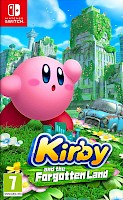Review: Kirby and the Forgotten Land

Posted 28 Apr 2022 at 19:01 by Dean Anderson
Well, it’s certainly been a long time coming. Mario, Zelda, Metroid, F-Zero (remember that one?); they all made the jump into the 3rd dimension way back in the late 90s and early 2000s to great success. But there was always one Nintendo staple character who never seemed to be able to make the leap… for whatever reason, their games stuck with the 2D sidescrolling perspective despite their ravenous appetite. I am, of course, talking about Yoshi! What!? What do you mean that’s the wrong character?! He hasn’t gotten a 3D game yet!! Oh… right, you mean the other Nintendo character who forgot to make the jump into 3D… fine I guess we’ll talk about him then.
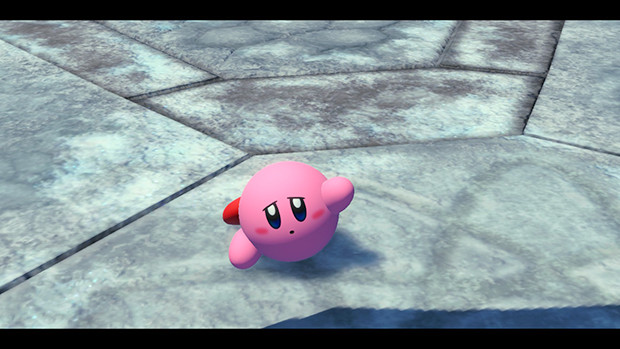
How could you just leave me back there Nintendo!?
Kirby 64: The Crystal Shards was very much unlike Nintendo’s other 64-bit sequel efforts. While the likes of Super Mario 64 and The Legend of Zelda: Ocarina of Time were setting the world on fire with bold steps into the world of 3D, coming with radical changes to their respective series’ signature gameplay, Kirby’s 64-bit outing was instead a traditional 2D sidescroller; albeit with a 3D polygonal makeover. While it was a fine game in its own right, and ironically a bit of a breath of fresh air in a world that was pushing everything towards 3D gameplay, many Kirby fans have been pining for a true 3D platforming outing ever since.
Twenty-two years later and HAL Laboratory have finally delivered on that age old promise! Naturally, this means that Kirby and the Forgotten Land comes with a lot of historical baggage and a ton of player expectations. Just what would a 3D Kirby game even play like!? Would it see the radical shift in gameplay that the Mario, Zelda and Metroid series did? And would it retain the Kirby series’ signature gameplay features that have kept it going for the past 22 years? The answer, I think, will surprise many of you; because this is perhaps the smoothest transition into 3D that I feel that any Nintendo series has ever seen.
While Super Mario 64 eschewed the traditional Course Clear structure of the original 2D sidescrolling NES & SNES entries, and Metroid Prime gave up the brisk pacing and acrobatic platforming gameplay of the 2D Metroid titles in favour of an immersive first-person perspective; Kirby & The Forgotten Land makes no such sacrifices. All of the fast-paced high NRG action of the 2D titles is fully preserved here, as is the traditional Course Clear gameplay structure and breezy nature of the series’ signature platforming & combat mechanics. This feels like a completely natural extension of the 2D series; and while this may disappoint some who wanted to see a more radical departure from the classic 2D Kirby gameplay, long-time fans will be very pleased with how this game effortlessly transitions and expands upon the gameplay that they know and love.
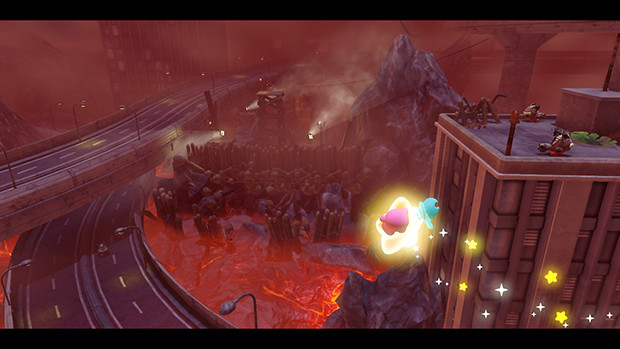
My little post-apocalyptic world can’t possibly be this cute!
Kirby and the Forgotten Land plays very much how one would expect from a 2D Kirby title. It features fast-paced platforming with a linear stage structure, akin to the more modern 2D Kirby titles such as Kirby: Planet Robobot; however, it also features a much stronger focus on exploration to find secret passages, hidden items and such in order to complete a series of missions (five in total per-stage). If you are thinking that this mission structure sounds quite similar to Kirby’s Dreamland 3, you’d be very right!
So how then can HAL Laboratory marry the fast-paced action gameplay of the likes of Kirby: Planet Robobot with the more methodological and slower-paced exploratory gameplay of Kirby’s Dreamland 3? The answer lies within this game’s big gimmick, the jump to 3D itself, as the more open level design that is afforded by the jump to fully 3D space allows for HAL Laboratory’s level designers to craft stages that feature a fast-paced and action focused critical path, while also featuring ample side paths and hidden areas for more intrepid players to uncover.
The result is a game that manages to satisfy all fans of the pink blob’s previous outings; and really, this is a testament to just how well designed the game’s stages truly are. A very delicate balance is kept between fast-paced action and slower-paced exploration that I feel does succeed at satisfying both factions; a design challenge that most other games who set out to achieve this, utterly fail at accomplishing. Ability hats off to the level designers at HAL Laboratory for the utterly stellar work done on this title, you’ve all done a fine job!
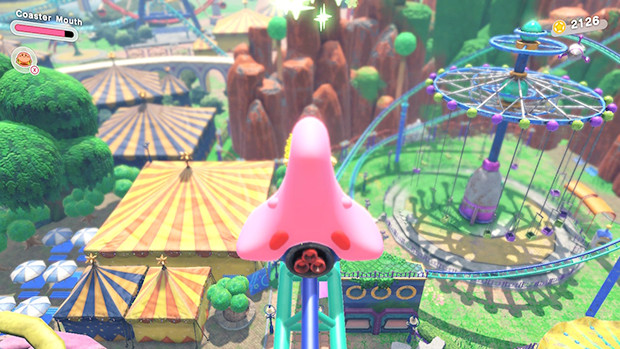
It's a me! Wari… oh… I mean, KIRBY!
So then, what about the game’s other main new gimmicks? You’ve probably already heard plenty about the new Mouthful Mode, Kirby’s hilarious, and somewhat terrifying, ability to wrap his pink… flesh?... around an object and possess its qualities much like Cappy’s power in Super Mario Odyssey. These are temporary powers that play out in a fairly similar fashion as in Mario’s other Switch title, but these are instead used for specific set pieces within each stage. These add some nice variety to each stage and are always a welcome sight; though will surely bring about some nightmares for younger players.
They also feel sufficiently distinct from Kirby’s signature Copy Abilities, which also make a return appearance; however, they feel perhaps a bit too few in number… then again, so too do the Copy Abilities themselves. With only a scant 12 Copy Abilities available, and no way to combine them as in Kirby’s Dreamland 3 or Kirby 64: The Crystal Shards this represents the smallest number of Copy Abilities ever seen in a mainline Kirby title. Thankfully though, each ability is very fun to use and has a number of optional upgrades that can be unearthed and collected for those who seek out those aforementioned hidden paths and secrets; which adds some much needed variety.
On the flip-side however, keen eyed players will likely figure out quickly that the roster of Copy Abilities is rather unbalanced; as there is one standout Copy Ability that utterly dominates overall… and that is Sword. Put simply, there is absolutely no reason to use anything other than Sword unless you’re either forced to, or you want to self-impose a challenge; as Sword becomes perhaps the single most utterly overpowered ability in Kirby history… and that is in a game where they managed to make Tornado and Needle actually good! That’s really saying something!
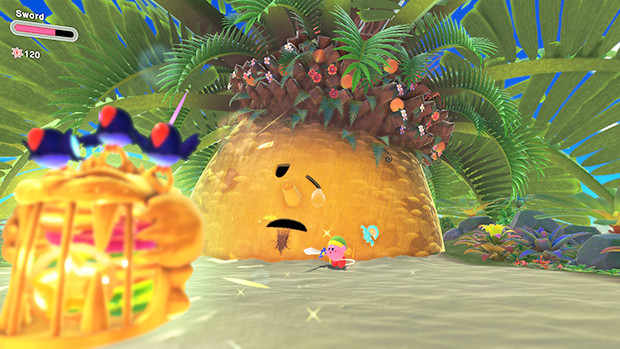
Of course I battered him, I was using Sword!
I need to highlight the combat mechanics a bit more here however, as HAL Laboratory have done a superb job at transitioning them into 3D. Never once did I feel that a whiff was unjustified, and never once did I feel that the perspective was an issue. The camera work is superb, and the combat oh so satisfying. The Kirby series has always secretly been a bit of a Stylish Action game, with excellent combat mechanics, and this gameplay is only magnified further by the additional dimension; in fact, it even lifts the Witch Time mechanic wholesale from Bayonetta with its new multi-directional dodging system.
Kirby has clearly been learning some tips from watching her in Super Smash Bros Ultimate, and I reckon that fans of the Stylish Action genre may well get a bit of a kick out of this game. While some fans might be a little disappointed with the reduced moveset compared to the more modern 2D titles, I feel that the new dodging mechanics and 3D movement add enough of a unique spice to more than make up for this.
That being said however? It has to be mentioned that the enemy variety is a bit lacking. With only 4 minibosses in total, and a rather small cast of foes by series standards (owing to there only being 12 Copy Abilities available); you’re gonna be fighting the same enemies and minibosses pretty often. Thankfully however, there’s enough big boss variety to satisfy; and they’re all excellently designed with plenty of interesting attack patterns to learn and master. The stages themselves are also filled with interesting gimmicks and platforming challenges that keep the gameplay feeling fresh all throughout its running time, despite the somewhat small cast of baddies.
The issue of difficulty is inevitably going to be a divisive one; while the likes of Dark Souls gets flack for being oppressive and imposingly difficult to a wide audience, the Kirby series is often resented for the exact opposite. Kirby and the Forgotten Land is no exception to the rest of the series in that it is largely a breezy adventure that won’t put up a huge challenge to most players; however, like most of the previous Kirby titles before it, the post-game content does put up a healthy challenge for those that want it… well, as long as you don’t just abuse Sword that is!
Go into this game knowing that the main game is a spring breeze, while getting 100% is surprisingly elusive; in fact, the mission structure might actually frustrate completionist players somewhat, as it requires multiple playthroughs of each stage in order to find out exactly what needs to be done in order to trigger the completion of each mission… it can feel a bit grindy in that regard. Also, those Treasure Road par times are no joke! Seriously! Good luck beating them!
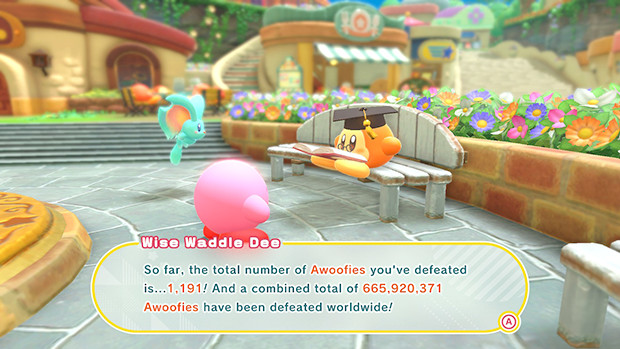
The happiest genocide that you’ll ever experience!
Kirby and the Forgotten Land is a beautiful game that runs very well in both Docked and Handheld modes at a mostly full fat 1080p/720p, running at a near locked 30FPS. It’s a good step up from Kirby: Star Allies from a technical standpoint and its definitely one of the nicest looking games on the Switch, with very little to complain about in terms of visuals. The presentation and production values are top-notch from start to finish, and the same is true of the music. While I wouldn’t say that it’s my favourite soundtrack in the series (that is a VERY high bar to clear to be fair!), the soundscape is delightful and also horrifying in the right places.
I do feel however, that the game relies a bit too heavily on the use of leitmotif throughout its soundtrack though; as the overuse of the main theme starts to feel a bit repetitive after a while. It attempts to pull a bit of a Super Mario World as it weaves the main theme into different kinds of tunes, but I don’t feel that it’s a fully successful attempt here. By no means bad, and certainly good enough to happily earn a spot onto my music playlist, but perhaps a little short of the series’ previous highs.
N-Europe Final Verdict
Kirby’s transition into 3D is a resounding success that will greatly please long-time fans. While those of you that aren’t huge fans of Kirby’s classic breezy gameplay perhaps won’t find all that much here to convert you, the jump to 3D has allowed the designers at HAL Laboratory to really bring out the best of all the series’ signature aspects. Kirby and the Forgotten Land is an expertly crafted mix of high NRG action and more methodological exploratory gameplay that will satisfy anyone hankering for a traditional handcrafted platforming title.
- Gameplay5
- Playability5
- Visuals5
- Audio4
- Lifespan4
Final Score
9
Pros
+ Excellent handcrafted level design that tidily straddles the thin line between fast-paced action and slower-paced exploratory gameplay
+ Fantastic Stylish Action combat mechanics that effortlessly transition from 2D to 3D gameplay
+ Beautiful visuals, wonderful music and huge production values married to breezy and fun gameplay that will bring a smile to all but the most jaded of faces
+ So cute that it should come with a government health warning
Cons
- Those looking for a more radical departure from Kirby’s classic gameplay may be somewhat disappointed
- The enemy and Copy Ability variety is a bit low compared to past entries in the series
- Sword is so OP that it makes everything else feel a bit redundant in comparison
- Getting that elusive 100% completion can feel a bit grindy


